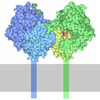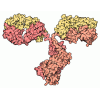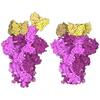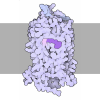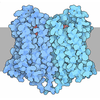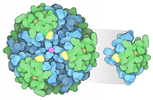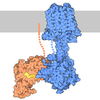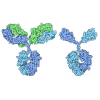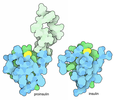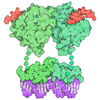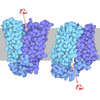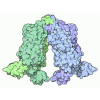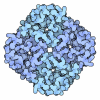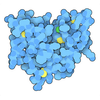+ データを開く
データを開く
- 基本情報
基本情報
| 登録情報 | データベース: PDB / ID: 8k6m | ||||||
|---|---|---|---|---|---|---|---|
| タイトル | Structural complex of neuropeptide Y receptor 1 | ||||||
 要素 要素 |
| ||||||
 キーワード キーワード | MEMBRANE PROTEIN / neuropeptide Y receptor 1 / complex | ||||||
| 機能・相同性 |  機能・相同性情報 機能・相同性情報pancreatic polypeptide receptor activity / peptide YY receptor activity / neuropeptide Y receptor activity / positive regulation of appetite / neuropeptide Y receptor binding / intestinal epithelial cell differentiation / synaptic signaling via neuropeptide / negative regulation of adenylate cyclase-activating adrenergic receptor signaling pathway / adult feeding behavior / neuropeptide receptor activity ...pancreatic polypeptide receptor activity / peptide YY receptor activity / neuropeptide Y receptor activity / positive regulation of appetite / neuropeptide Y receptor binding / intestinal epithelial cell differentiation / synaptic signaling via neuropeptide / negative regulation of adenylate cyclase-activating adrenergic receptor signaling pathway / adult feeding behavior / neuropeptide receptor activity / negative regulation of calcium ion-dependent exocytosis / G protein-coupled adenosine receptor signaling pathway / positive regulation of urine volume / negative regulation of adenylate cyclase activity / neuropeptide hormone activity / positive regulation of neural precursor cell proliferation / negative regulation of synaptic transmission / neuropeptide binding / feeding behavior / gamma-aminobutyric acid signaling pathway / neuronal dense core vesicle / central nervous system neuron development / outflow tract morphogenesis / negative regulation of apoptotic signaling pathway / regulation of calcium ion transport / G protein-coupled receptor signaling pathway, coupled to cyclic nucleotide second messenger / regulation of multicellular organism growth / neuropeptide signaling pathway / FOXO-mediated transcription of oxidative stress, metabolic and neuronal genes / Adenylate cyclase inhibitory pathway / positive regulation of vascular associated smooth muscle cell proliferation / calcium channel regulator activity / sensory perception of pain / response to nutrient / hippocampal mossy fiber to CA3 synapse / Peptide ligand-binding receptors / positive regulation of superoxide anion generation / GABA-ergic synapse / locomotory behavior / Regulation of insulin secretion / G protein-coupled receptor binding / adenylate cyclase-inhibiting G protein-coupled receptor signaling pathway / G protein-coupled receptor activity / cerebral cortex development / regulation of blood pressure / G-protein beta/gamma-subunit complex binding / Olfactory Signaling Pathway / Activation of the phototransduction cascade / G beta:gamma signalling through PLC beta / Presynaptic function of Kainate receptors / Thromboxane signalling through TP receptor / G protein-coupled acetylcholine receptor signaling pathway / adenylate cyclase-activating G protein-coupled receptor signaling pathway / G-protein activation / Activation of G protein gated Potassium channels / Inhibition of voltage gated Ca2+ channels via Gbeta/gamma subunits / Prostacyclin signalling through prostacyclin receptor / G beta:gamma signalling through CDC42 / Glucagon signaling in metabolic regulation / glucose metabolic process / neuron projection development / G beta:gamma signalling through BTK / Synthesis, secretion, and inactivation of Glucagon-like Peptide-1 (GLP-1) / ADP signalling through P2Y purinoceptor 12 / Sensory perception of sweet, bitter, and umami (glutamate) taste / photoreceptor disc membrane / Glucagon-type ligand receptors / Adrenaline,noradrenaline inhibits insulin secretion / Vasopressin regulates renal water homeostasis via Aquaporins / G alpha (z) signalling events / Glucagon-like Peptide-1 (GLP1) regulates insulin secretion / ADORA2B mediated anti-inflammatory cytokines production / cellular response to catecholamine stimulus / ADP signalling through P2Y purinoceptor 1 / G beta:gamma signalling through PI3Kgamma / adenylate cyclase-activating dopamine receptor signaling pathway / Cooperation of PDCL (PhLP1) and TRiC/CCT in G-protein beta folding / GPER1 signaling / Inactivation, recovery and regulation of the phototransduction cascade / cellular response to prostaglandin E stimulus / G-protein beta-subunit binding / heterotrimeric G-protein complex / G alpha (12/13) signalling events / sensory perception of taste / extracellular vesicle / signaling receptor complex adaptor activity / Thrombin signalling through proteinase activated receptors (PARs) / cell body / GTPase binding / Ca2+ pathway / retina development in camera-type eye / midbody / High laminar flow shear stress activates signaling by PIEZO1 and PECAM1:CDH5:KDR in endothelial cells / fibroblast proliferation / G alpha (i) signalling events / G alpha (s) signalling events / phospholipase C-activating G protein-coupled receptor signaling pathway / chemical synaptic transmission / G alpha (q) signalling events / ciliary basal body 類似検索 - 分子機能 | ||||||
| 生物種 |  Homo sapiens (ヒト) Homo sapiens (ヒト) | ||||||
| 手法 | 電子顕微鏡法 / 単粒子再構成法 / クライオ電子顕微鏡法 / 解像度: 3.3 Å | ||||||
 データ登録者 データ登録者 | Shen, S.Y. / Zhao, C. / Shao, Z.H. | ||||||
| 資金援助 |  中国, 1件 中国, 1件
| ||||||
 引用 引用 |  ジャーナル: MedComm (2020) / 年: 2024 ジャーナル: MedComm (2020) / 年: 2024タイトル: Structural basis of neuropeptide Y signaling through Y and Y receptors. 著者: Siyuan Shen / Yue Deng / Chenglong Shen / Haidi Chen / Lin Cheng / Chao Wu / Chang Zhao / Zhiqian Yang / Hanlin Hou / Kexin Wang / Zhenhua Shao / Cheng Deng / Feng Ye / Wei Yan /  要旨: Neuropeptide Y (NPY), a 36-amino-acid peptide, functions as a neurotransmitter in both the central and peripheral nervous systems by activating the NPY receptor subfamily. Notably, NPY analogs ...Neuropeptide Y (NPY), a 36-amino-acid peptide, functions as a neurotransmitter in both the central and peripheral nervous systems by activating the NPY receptor subfamily. Notably, NPY analogs display varying selectivity and exert diverse physiological effects through their interactions with this receptor family. [Pro]-NPY and [Leu, Pro]-NPY, mainly acting on YR, reportedly increases blood pressure and postsynaptically potentiates the effect of other vasoactive substances above all, while N-terminal cleaved NPY variants in human body primary mediates angiogenesis and neurotransmitter release inhibition through YR. However, the recognition mechanisms of YR and YR with specific agonists remain elusive, thereby hindering subtype receptor-selective drug development. In this study, we report three cryo-electron microscopy (cryo-EM) structures of Gi2-coupled YR and YR in complexes with NPY, as well as YR bound to a selective agonist [Leu, Pro]-NPY. Combined with cell-based assays, our study not only reveals the conserved peptide-binding mode of NPY receptors but also identifies an additional sub-pocket that confers ligand selectivity. Moreover, our analysis of YR evolutionary dynamics suggests that this sub-pocket has undergone functional adaptive evolution across different species. Collectively, our findings shed light on the molecular underpinnings of neuropeptide recognition and receptor activation, and they present a promising avenue for the design of selective drugs targeting the NPY receptor family. | ||||||
| 履歴 |
|
- 構造の表示
構造の表示
| 構造ビューア | 分子:  Molmil Molmil Jmol/JSmol Jmol/JSmol |
|---|
- ダウンロードとリンク
ダウンロードとリンク
- ダウンロード
ダウンロード
| PDBx/mmCIF形式 |  8k6m.cif.gz 8k6m.cif.gz | 223 KB | 表示 |  PDBx/mmCIF形式 PDBx/mmCIF形式 |
|---|---|---|---|---|
| PDB形式 |  pdb8k6m.ent.gz pdb8k6m.ent.gz | 172.7 KB | 表示 |  PDB形式 PDB形式 |
| PDBx/mmJSON形式 |  8k6m.json.gz 8k6m.json.gz | ツリー表示 |  PDBx/mmJSON形式 PDBx/mmJSON形式 | |
| その他 |  その他のダウンロード その他のダウンロード |
-検証レポート
| 文書・要旨 |  8k6m_validation.pdf.gz 8k6m_validation.pdf.gz | 1.1 MB | 表示 |  wwPDB検証レポート wwPDB検証レポート |
|---|---|---|---|---|
| 文書・詳細版 |  8k6m_full_validation.pdf.gz 8k6m_full_validation.pdf.gz | 1.2 MB | 表示 | |
| XML形式データ |  8k6m_validation.xml.gz 8k6m_validation.xml.gz | 41.7 KB | 表示 | |
| CIF形式データ |  8k6m_validation.cif.gz 8k6m_validation.cif.gz | 62.1 KB | 表示 | |
| アーカイブディレクトリ |  https://data.pdbj.org/pub/pdb/validation_reports/k6/8k6m https://data.pdbj.org/pub/pdb/validation_reports/k6/8k6m ftp://data.pdbj.org/pub/pdb/validation_reports/k6/8k6m ftp://data.pdbj.org/pub/pdb/validation_reports/k6/8k6m | HTTPS FTP |
-関連構造データ
| 関連構造データ |  36923MC  8k6nC 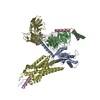 8k6oC M: このデータのモデリングに利用したマップデータ C: 同じ文献を引用 ( |
|---|---|
| 類似構造データ | 類似検索 - 機能・相同性  F&H 検索 F&H 検索 |
- リンク
リンク
- 集合体
集合体
| 登録構造単位 | 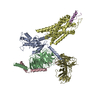
|
|---|---|
| 1 |
|
- 要素
要素
-Guanine nucleotide-binding protein ... , 3種, 3分子 ABC
| #1: タンパク質 | 分子量: 40516.891 Da / 分子数: 1 / 変異: S47N,G204A,E246A,A327S / 由来タイプ: 組換発現 / 由来: (組換発現)  Homo sapiens (ヒト) / 遺伝子: GNAI2, GNAI2B Homo sapiens (ヒト) / 遺伝子: GNAI2, GNAI2B発現宿主:  参照: UniProt: P04899 |
|---|---|
| #2: タンパク質 | 分子量: 39141.793 Da / 分子数: 1 / 由来タイプ: 組換発現 / 由来: (組換発現)  Homo sapiens (ヒト) / 遺伝子: GNB1 Homo sapiens (ヒト) / 遺伝子: GNB1発現宿主:  参照: UniProt: P62873 |
| #3: タンパク質 | 分子量: 7861.143 Da / 分子数: 1 / 由来タイプ: 組換発現 / 由来: (組換発現)  Homo sapiens (ヒト) / 遺伝子: GNG2 Homo sapiens (ヒト) / 遺伝子: GNG2発現宿主:  参照: UniProt: P59768 |
-Neuropeptide ... , 2種, 2分子 DE
| #4: タンパク質 | 分子量: 40569.445 Da / 分子数: 1 / 由来タイプ: 組換発現 / 由来: (組換発現)  Homo sapiens (ヒト) / 遺伝子: NPY1R, NPYR, NPYY1 Homo sapiens (ヒト) / 遺伝子: NPY1R, NPYR, NPYY1発現宿主:  参照: UniProt: P25929 |
|---|---|
| #6: タンパク質・ペプチド | 分子量: 4278.720 Da / 分子数: 1 / 由来タイプ: 合成 / 由来: (合成)  Homo sapiens (ヒト) / 参照: UniProt: P01303 Homo sapiens (ヒト) / 参照: UniProt: P01303 |
-抗体 , 1種, 1分子 S
| #5: 抗体 | 分子量: 28636.793 Da / 分子数: 1 / 由来タイプ: 組換発現 / 由来: (組換発現)  発現宿主:  |
|---|
-詳細
| Has protein modification | Y |
|---|
-実験情報
-実験
| 実験 | 手法: 電子顕微鏡法 |
|---|---|
| EM実験 | 試料の集合状態: PARTICLE / 3次元再構成法: 単粒子再構成法 |
- 試料調製
試料調製
| 構成要素 | 名称: Structural complex of neuropeptide Y receptor 1 / タイプ: COMPLEX / Entity ID: all / 由来: RECOMBINANT |
|---|---|
| 由来(天然) | 生物種:  Homo sapiens (ヒト) Homo sapiens (ヒト) |
| 由来(組換発現) | 生物種:  |
| 緩衝液 | pH: 7.5 |
| 試料 | 包埋: NO / シャドウイング: NO / 染色: NO / 凍結: YES |
| 急速凍結 | 凍結剤: ETHANE |
- 電子顕微鏡撮影
電子顕微鏡撮影
| 実験機器 |  モデル: Titan Krios / 画像提供: FEI Company |
|---|---|
| 顕微鏡 | モデル: FEI TITAN KRIOS |
| 電子銃 | 電子線源:  FIELD EMISSION GUN / 加速電圧: 300 kV / 照射モード: FLOOD BEAM FIELD EMISSION GUN / 加速電圧: 300 kV / 照射モード: FLOOD BEAM |
| 電子レンズ | モード: BRIGHT FIELD / 最大 デフォーカス(公称値): 1800 nm / 最小 デフォーカス(公称値): 1000 nm |
| 撮影 | 電子線照射量: 57 e/Å2 フィルム・検出器のモデル: GATAN K2 SUMMIT (4k x 4k) |
- 解析
解析
| CTF補正 | タイプ: PHASE FLIPPING AND AMPLITUDE CORRECTION | ||||||||||||||||||||||||
|---|---|---|---|---|---|---|---|---|---|---|---|---|---|---|---|---|---|---|---|---|---|---|---|---|---|
| 3次元再構成 | 解像度: 3.3 Å / 解像度の算出法: FSC 0.143 CUT-OFF / 粒子像の数: 127586 / 対称性のタイプ: POINT | ||||||||||||||||||||||||
| 拘束条件 |
|
 ムービー
ムービー コントローラー
コントローラー





 PDBj
PDBj